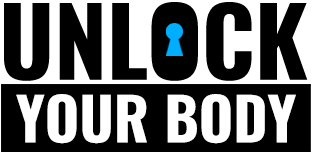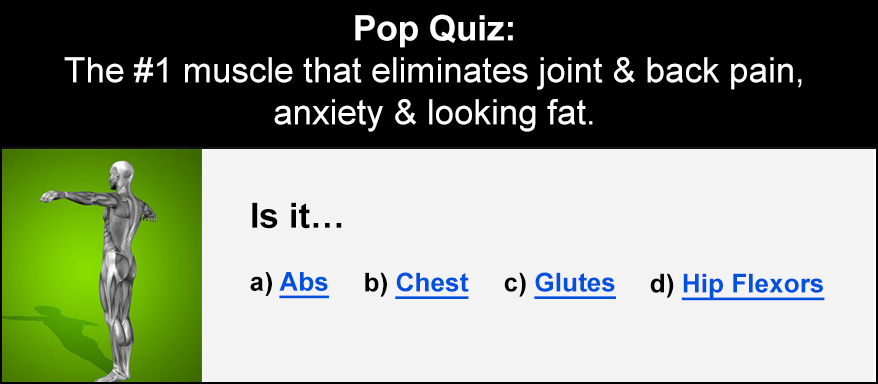When we say “barbell exercises,” many people think they’re only for men. However, this isn’t the case. Many barbells or weighted exercises for women are suitable for their body type. Barbell exercises are ideal for those who want to lose weight and get fitter. The movements involved are very compound and taxing on the body. Barbell exercises also help you work multiple muscles at once, thus increasing your overall metabolic activity and weight loss.
You’re in the right place if you’re looking to get stronger and leaner and sculpt your arms, shoulders, back, and core. In this blog post, you’ll learn everything you need to know about barbell training for women so that you don’t have to feel intimidated. You’ll discover which barbell exercises are best for women, what type of bar suits your strength-training needs, and how much weight you should lift.
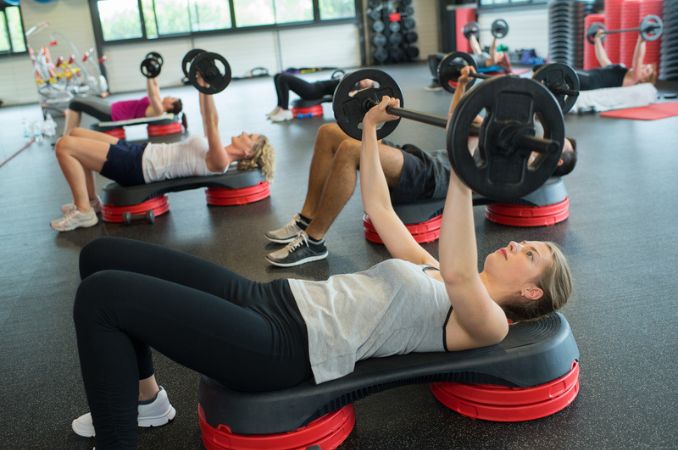
Barbell exercises offer you several benefits:
- Strength & Power: They help you get stronger, gain muscle, and control weight.
- Full Body Exercises: An exercise program that engages your entire body.
- Suitable For All, No Matter The Gender: Barbell exercises are great for building strength and muscle in both men and women.
- Build Beautiful Muscles: Barbells are the most versatile and effective strength training equipment for building muscle and strength.
- Helps Increase Metabolism: Barbell exercises produce more growth hormones in your body, which is responsible for an increase in the burning of fat.
- Look Healthier & Sexier: They tone your body and improve your posture, making you look healthier and sexier. They also improve your mental health by reducing stress and improving your self-confidence.
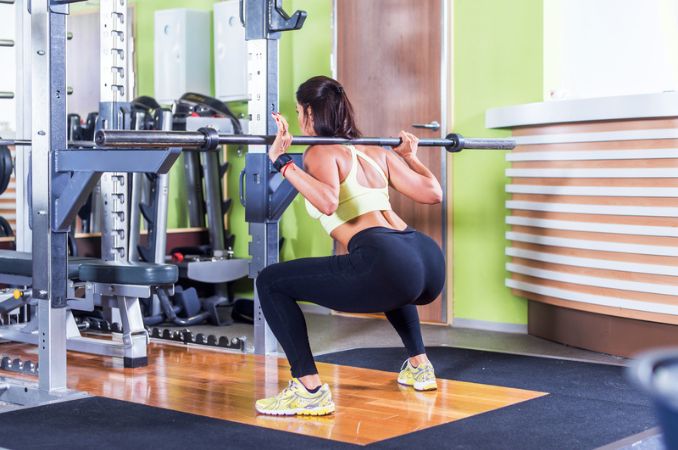
Which Barbell Exercises are Suitable for Women?
Barbell training is one of the most effective ways to burn fat. Women are often wary of barbell training because they think barbells are too heavy, dangerous, or won’t suit them. Yet nothing could be further from the truth.
You don’t have to do barbell exercises exclusively if you’re a beginner. Start with a more accessible version of any weighted exercises you think you can do, which will still give you great results. If you don’t have any access to a barbell, you can also use kettlebells or dumbbells. The best types of exercises are those you enjoy while ensuring you follow proper form and technique.
With that in mind, let’s look at some effective weighted exercises suitable for women.
1. Single Arm Press
When you press a single weighted arm overhead, your shoulders and scapular stabilizers must work harder to keep the weight balanced and stable. As a result, you get stronger faster. A single-arm press is an excellent move to strengthen these smaller but mighty muscles. It’s also a great way to add variety to your shoulder workouts with little risk of injury.
Here’s how to do it:
Begin in an upright standing position with your feet hip-width apart, maintaining good alignment with your head, shoulders, hips, and legs. Hold a kettlebell or dumbbell in one hand at shoulder height with your palm facing outward. Engage your core muscles and press your arm overhead. Lower your arm to bring your elbow to a 90-degree angle. Repeat the movement. Start with 1 set of 5 – 10 repetitions on each side, increasing your sets as you feel.
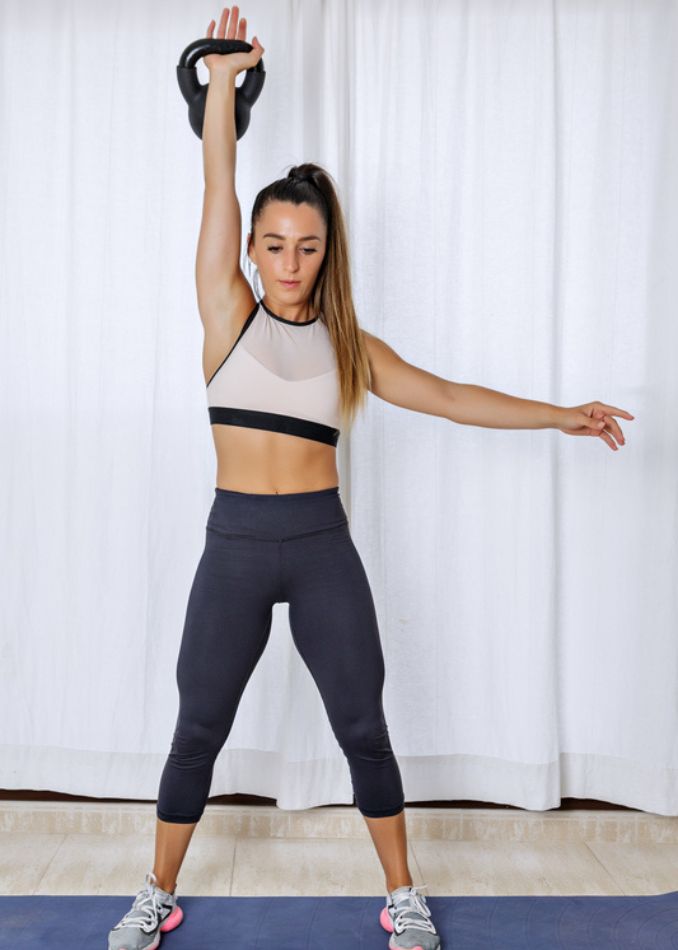
2. Weighted Reverse Lunge
You generally work the quadriceps and glutes during weighted reverse lunges. By contracting the glutes for several seconds at the top of each movement, you can increase the tension on these muscles.
Here’s how to do it:
Begin in an upright standing position with your feet shoulder-width apart, maintaining good alignment with your head, shoulders, hips, and legs. Hold a kettlebell with both hands in front of your body, or hold a dumbbell in each hand. Contract your core muscles. Take a big step back with one foot, then lower your back knee towards the ground. Raise back up to the starting position. Repeat the movement. Start with 1 set of 5 repetitions on each side.

3. Single Arm Press & Reverse Lunge
Add a variation to your weighted workout for a full-body benefit. You can do a single arm press and reverse lunge, for instance, a combination of power and strength training. These exercises will work your arms, chest, shoulders, and legs. Just be sure to maintain proper form with these exercises.
Here’s how to do it:
Begin in an upright standing position with your feet shoulder-width apart, maintaining good alignment in your upper body. Hold a kettlebell or dumbbell in one hand at shoulder height with your palm facing outward. Tighten your core. Take a big step back with one foot and lower your back knee to the ground. Raise back up and straighten your arm to push the kettlebell overhead. Repeat the movement. Start with 1 set of 5 repetitions on each side.

4. Barbell Squat
Barbell squats engage multiple body parts, including your quads, glutes, and calves. They also improve posture and reduce back pain. For your safety, you may want to start with the bar on the supports of a squat rack at chest height.
Here’s how to do it:
Begin in an upright standing position with your legs shoulder–width apart and your toes slightly pointed outward. Hold the barbell across your shoulders with your arms wide and your palms facing outward. Tighten your core, bend your knees, and hinge through your hips to lower your seat into a squat position. Raise back up to the starting position and repeat the movement.
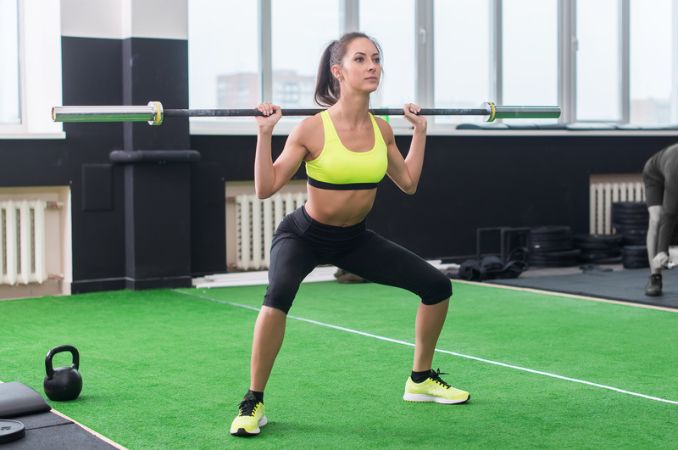
5. Barbell Deadlift
The barbell deadlift is a compound exercise that targets the entire posterior chain. It’s imperative to maintain a neutral spine during this exercise to avoid unnecessary back stress and get the most benefit from the exercise.
Here’s how to do it:
Begin in an upright position in front of the barbell with your feet hip-width apart. Bend your 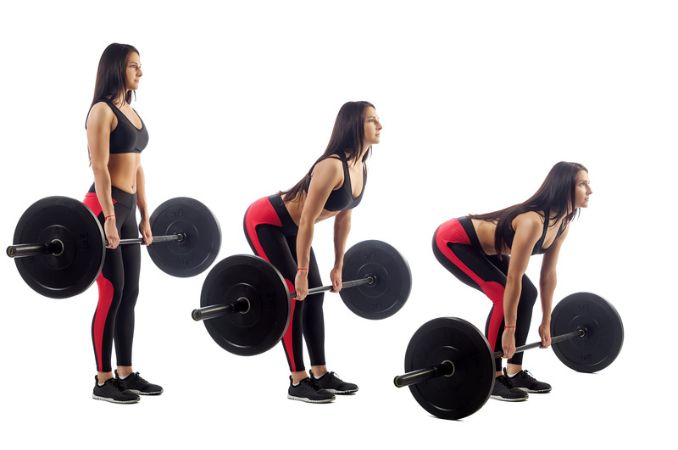 knees and pivot through your hips to bend your upper body forward. Hold the barbell with an overhand grip. Ideally, your back should be parallel to the floor. Engage your core and keep your eyes fixed on a focal point in front of you. Inhale and squeeze your glutes as you raise back up to a standing position, lifting the barbell off the floor while keeping the bar close to your legs. Exhale, bend your knees again and hinge through your hips to slowly lower the barbell back to the floor. Repeat the movement.
knees and pivot through your hips to bend your upper body forward. Hold the barbell with an overhand grip. Ideally, your back should be parallel to the floor. Engage your core and keep your eyes fixed on a focal point in front of you. Inhale and squeeze your glutes as you raise back up to a standing position, lifting the barbell off the floor while keeping the bar close to your legs. Exhale, bend your knees again and hinge through your hips to slowly lower the barbell back to the floor. Repeat the movement.
6. Barbell Bench Press
You can use barbell bench presses to help improve posture, increase shoulder mobility, and reduce symptoms of shoulder pain. You can perform this exercise by using a traditional bench or squat rack. Depending on your fitness level goals, there are several ways you can adjust the barbell bench press to make it easier or more challenging.
Here’s how to do it:
Use a workout bench or any stable inclined surface that you can lie on for this exercise.
Recline on the workout bench, ideally at 45 degrees, with your knees bent and feet flat on the floor. Maintain good alignment with your head, shoulders, and hips. Hold the barbell at chest level with your arms wide and palms facing outward. Contract your abdominal muscles and extend your arms, pressing the barbell towards the ceiling. Lower the barbell back down to the starting position. Repeat the movement.

Important Tips for Using a Barbell
For safety reasons, keep these points in mind while using a barbell.
- Make sure that you have bumper plates on the barbell when lifting weights. These are plates with soft edges that decrease the chances of injury in case of a fall.
- Barbells are available in different sizes, so make sure you choose the one that suits your height.
- Avoid bending at the hips as you lift the barbell.
- Keep your knees bent as you lift and lower the barbell.
- Avoid lifting hefty weights.
- Keep your shoulders relaxed and down as you lift and lower them.
- Keep a strong posture, with your head and shoulders back as you lift the barbell.
- Keep your hands about shoulder-width apart as you lift and lower the barbell.

The Truth About Barbell Exercises for Women
Weightlifting is not just for men. Barbell exercises are safer for women than many other exercises, thanks to their emphasis on functional strength rather than aesthetics.
There are no rules, but these guidelines will help you achieve your goals faster.
- If you’re trying to put on muscle, lift heavy.
- If you’re trying to lose weight, lift light.
- If you’re trying to stay healthy, lift whatever weight you’re comfortable with.
- If you’re trying to get stronger, lift heavier.
- If you’re trying to increase endurance, lift lighter.
- If you’re trying to reduce stress, lift whatever weight you’re comfortable with.
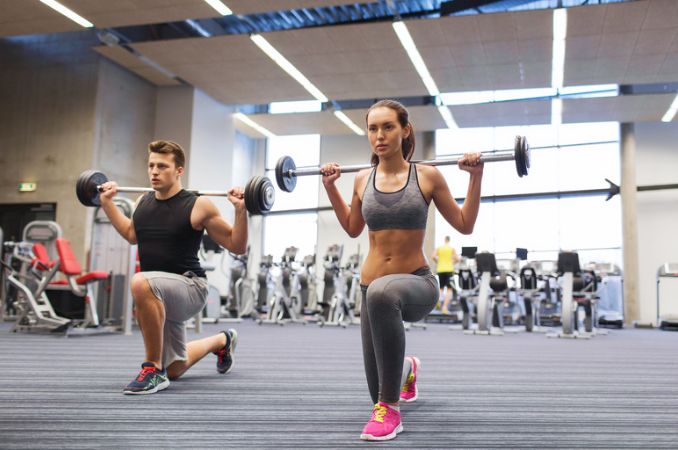
Anyone, regardless of gender, has the potential to benefit from lifting weights. Stop believing lifting weights will make women “bulky” or “manly.” Lifting weights strengthens you, and strength isn’t limited to bicep curls! Lifting heavy weights will make you stronger, but won’t necessarily make you bulky. Though we create bulky muscles through resistance training, generally, women don’t produce enough testosterone to build “manly” muscles.
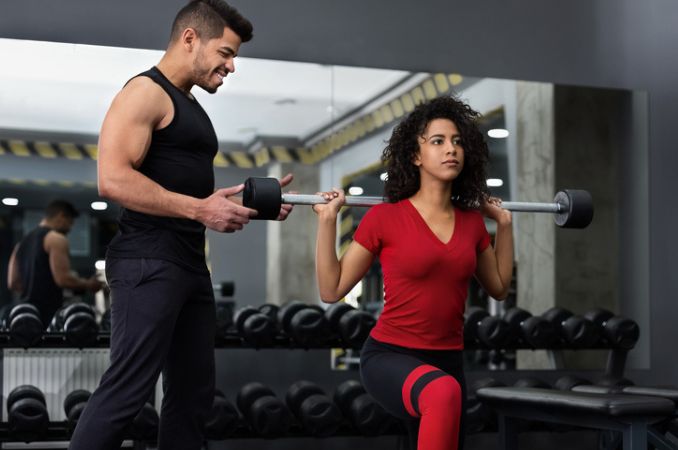
Weighted training is not a “one shoe fits all” approach. If you choose to use lighter weights (small dumbbells) instead of heavy barbells, modify your exercises however best. The important thing is that you’re still doing the training and benefiting from the exercises.
Ladies, if you’re feeling down about not being able to lift heavy like a man, don’t worry. While it might be tempting to compare your weightlifting form to your male counterparts, don’t do it. You’re not competing against anyone, so there’s no need to gauge who has the most impressive muscles. Instead, focus on making sure you’re safe and lifting with proper form.

